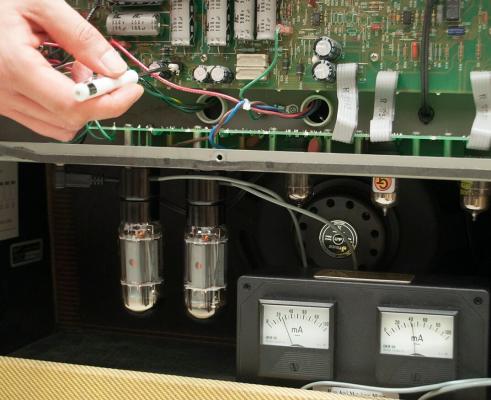Why Should I Match My Tubes?
Power tubes are electrically matched so each tube will have the same amount of “idle” plate current and amplification characteristics when used in an amplifier. This is done so the tubes can work together in your amp giving you optimal sound quality and tube longevity. Matched tubes also receive extra quality checks to reduce the possibility of getting a faulty power tube that may have slipped by the manufacturer. Let's look at some of the basics of how tubes work to have a better understanding of the benefits of using matched tubes versus unmatched power tubes in a guitar amp.
As seen in Fig. 1, the tube's cathode is its source of electrons. The filament is used to provide the heat necessary to release electrons from the cathode. Since electrons have a negative charge, the plate is given a positive voltage to attract them. The control grid is placed between the cathode and plate and is given a negative voltage to repel electrons and restrict their flow to the plate. If the grid is made more negative, the number of electrons passing through the grid is reduced. If the grid is made less negative, the number of electrons passing through the grid increases. The flow of electrons from cathode to plate when measured at the plate is called the “plate current.”
Matching comes into play because tubes vary in the amount of plate current flowing through them when given the same control grid and plate voltages. Adjusting the amount of negative control grid voltage for an optimal amount of idle plate current is referred to as “setting the bias.” In a fixed bias guitar amp, the negative grid voltage is set by adjusting a bias pot. If the bias pot is set too cold, the sound will be lacking in warmth. If the bias pot is set too hot, the tube will be overheating and the sound can be lacking in definition. Setting the bias involves finding a bias point where the amp sounds the best and the tubes are not overheating. As seen in the Fender® Blues Deluxe® amp of Fig. 2, the tube on the left has an idle plate current measurement of about 25 mA, while the tube on the right has about 42 mA. Why does this difference in idle plate current matter?
- 6L6GC tubes in that amp sound great when biased for about 35 mA of plate current, but with unmatched tubes, you can't get both tubes biased at that sweet spot.
- The tube with more plate current will be dissipating more power and getting hotter than the tube with less plate current. This means the tube on the right will wear out quicker than the tube on the left, leading to an earlier loss of clarity and definition.
Fig. 3 shows a matched pair of 6L6GC tubes in the same amp. What's the advantage?
- Both tubes can be biased at the sweet spot in this amp with about 35 mA of idle plate current.
- Both tubes are dissipating the same amount of power and can be adjusted together for optimal sound quality and tube longevity. They will allow for more playing time with rich, well defined tube tone.
Apex® matched tubes are matched for plate current and transconductance. Plate current matching makes sense. So what's transconductance? Think about it this way – the power tube conducts a certain amount of plate current depending on the amount of plate voltage and control grid voltage we apply to it. The “trans” in transconductance describes a change in conductance. Transconductance is a measurement of how much the plate current changes as a result of a corresponding change in the control grid voltage.
Why are Apex® matched tubes matched for transconductance in addition to plate current?
- To avoid a situation where the idle plate current is matched at one bias setting, but unmatched at another.
- Transconductance is related to the amount of amplification the tube provides at a particular bias setting. A higher transconductance means more amplification for the same signal. If two tubes are biased for the same amount of idle plate current, but provide different amounts of amplification, are they truly matched?
Why match tubes? It puts you in control of your tone. Matching the plate current and transconductance allows you to set the bias with maximum precision for that optimal sweet spot where the tubes will sound their best and won't burn out early.



